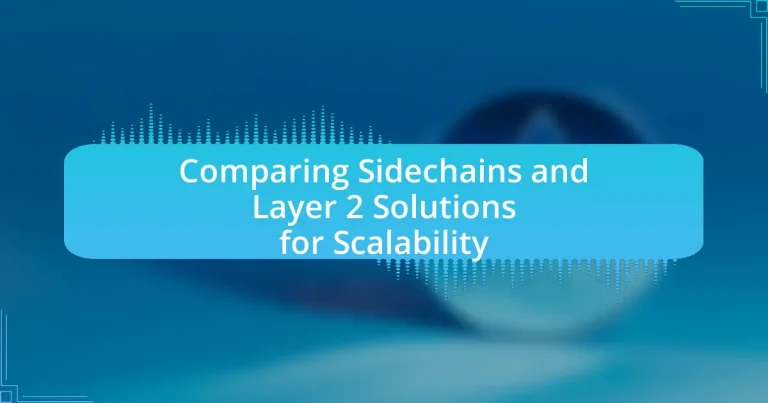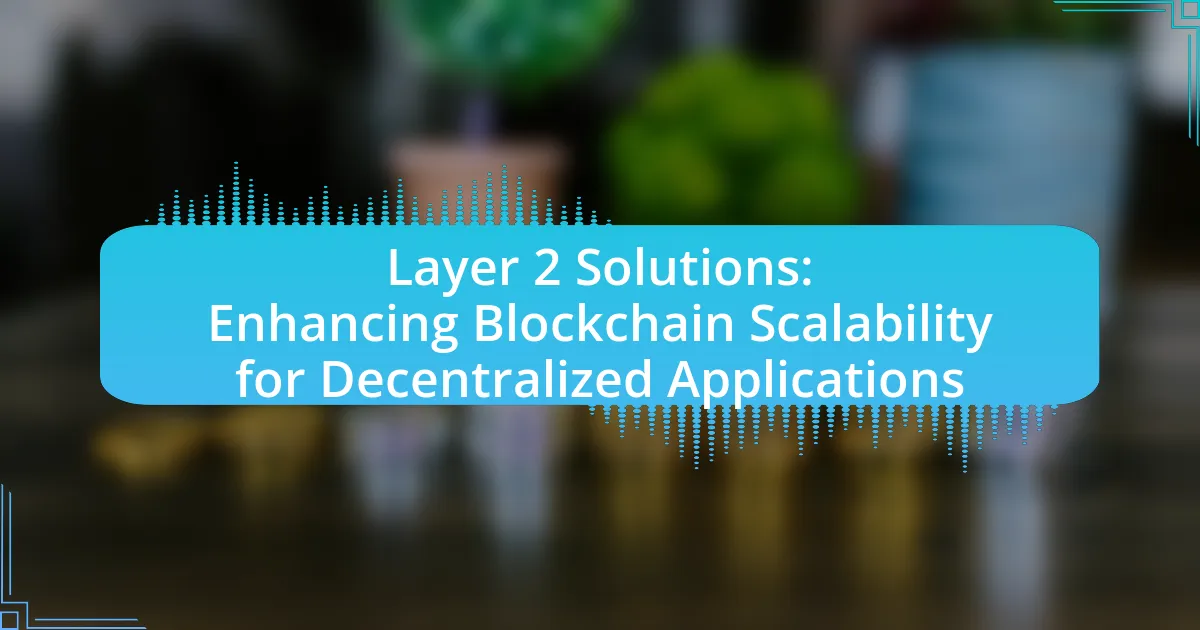The article focuses on comparing sidechains and Layer 2 solutions as methods for enhancing blockchain scalability. It defines sidechains as independent blockchains that operate parallel to a main blockchain, allowing asset transfers while maintaining their own consensus mechanisms. Layer 2 solutions, in contrast, are protocols built on top of a main blockchain to improve transaction speed and scalability without altering the base layer. The article discusses the key characteristics, advantages, and security implications of both approaches, as well as their respective roles in addressing scalability challenges and improving user experience across various industries. Additionally, it highlights best practices for implementing these solutions effectively.
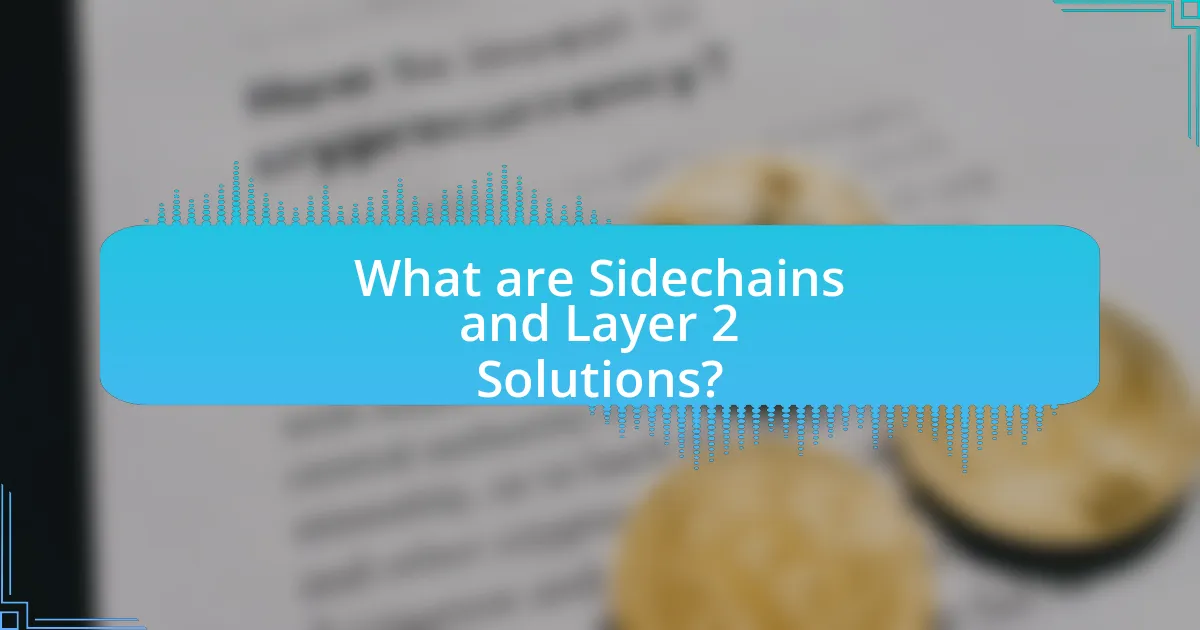
What are Sidechains and Layer 2 Solutions?
Sidechains are separate blockchains that run in parallel to a main blockchain, allowing for the transfer of assets between them while maintaining their own consensus mechanisms. Layer 2 solutions, on the other hand, are protocols built on top of a main blockchain to enhance scalability and transaction speed without altering the base layer. Both sidechains and Layer 2 solutions aim to alleviate congestion on the main blockchain, enabling faster and cheaper transactions. For instance, the Lightning Network is a prominent Layer 2 solution for Bitcoin that facilitates instant transactions, while the Liquid Network serves as a sidechain for Bitcoin, allowing for quicker transfers and enhanced privacy.
How do Sidechains differ from Layer 2 Solutions?
Sidechains differ from Layer 2 solutions primarily in their operational structure and purpose. Sidechains are independent blockchains that run parallel to the main blockchain, allowing for the transfer of assets between them, while Layer 2 solutions are built on top of the main blockchain to enhance scalability and transaction speed without altering the base layer. For example, Bitcoin’s Liquid Network serves as a sidechain that facilitates faster transactions, whereas the Lightning Network operates as a Layer 2 solution to enable instant payments on the Bitcoin network. This distinction highlights that sidechains can operate autonomously with their own consensus mechanisms, while Layer 2 solutions rely on the security and consensus of the main blockchain.
What are the key characteristics of Sidechains?
Sidechains are independent blockchains that run in parallel to a main blockchain, allowing for the transfer of assets between them. They feature interoperability, enabling assets to move seamlessly between the main chain and the sidechain, which enhances scalability by offloading transactions from the main chain. Sidechains also support different consensus mechanisms, allowing for tailored security and performance optimizations. Additionally, they can implement unique features and functionalities that may not be available on the main blockchain, providing flexibility for developers. The ability to customize transaction fees and speeds further distinguishes sidechains, making them a versatile solution for specific use cases.
What are the key characteristics of Layer 2 Solutions?
Layer 2 solutions are designed to enhance the scalability and efficiency of blockchain networks by processing transactions off the main blockchain (Layer 1). Key characteristics include increased transaction throughput, reduced latency, and lower transaction fees, as they alleviate congestion on the primary chain. Additionally, Layer 2 solutions often utilize mechanisms such as state channels, rollups, or sidechains to facilitate faster and cheaper transactions while maintaining security through the underlying Layer 1 blockchain. These solutions are crucial for enabling decentralized applications to scale effectively, as evidenced by the adoption of technologies like the Lightning Network for Bitcoin and Optimistic Rollups for Ethereum, which have demonstrated significant improvements in transaction speeds and costs.
Why are Sidechains and Layer 2 Solutions important for scalability?
Sidechains and Layer 2 solutions are crucial for scalability because they enable blockchains to process transactions more efficiently and reduce congestion on the main chain. By offloading transactions from the primary blockchain, these solutions can significantly increase throughput and lower transaction fees. For instance, the Lightning Network, a Layer 2 solution for Bitcoin, allows for thousands of transactions per second, compared to Bitcoin’s base layer, which handles approximately 7 transactions per second. This capability is essential for accommodating a growing number of users and applications, ensuring that blockchain technology can scale effectively to meet demand.
How do they address the limitations of the main blockchain?
Sidechains and Layer 2 solutions address the limitations of the main blockchain by enabling faster transactions and reducing congestion. Sidechains operate independently from the main blockchain, allowing for specific functionalities and scalability without burdening the primary network. For example, the Liquid Network, a Bitcoin sidechain, facilitates quicker transactions and confidential transfers, thereby alleviating pressure on the Bitcoin blockchain. Layer 2 solutions, such as the Lightning Network, enhance scalability by processing transactions off-chain and settling them later on the main blockchain, which significantly increases transaction throughput. These methods have been shown to improve transaction speeds and lower fees, as evidenced by the Lightning Network’s ability to handle millions of transactions per second compared to Bitcoin’s base layer, which processes approximately seven transactions per second.
What scalability challenges do they help overcome?
Sidechains and Layer 2 solutions help overcome scalability challenges such as transaction throughput limitations and network congestion. These technologies enable faster transaction processing by offloading some of the transaction load from the main blockchain, thereby increasing overall network efficiency. For instance, Layer 2 solutions like the Lightning Network can process thousands of transactions per second, significantly reducing the burden on the primary blockchain. Additionally, sidechains allow for parallel processing of transactions, which further alleviates congestion and enhances scalability.
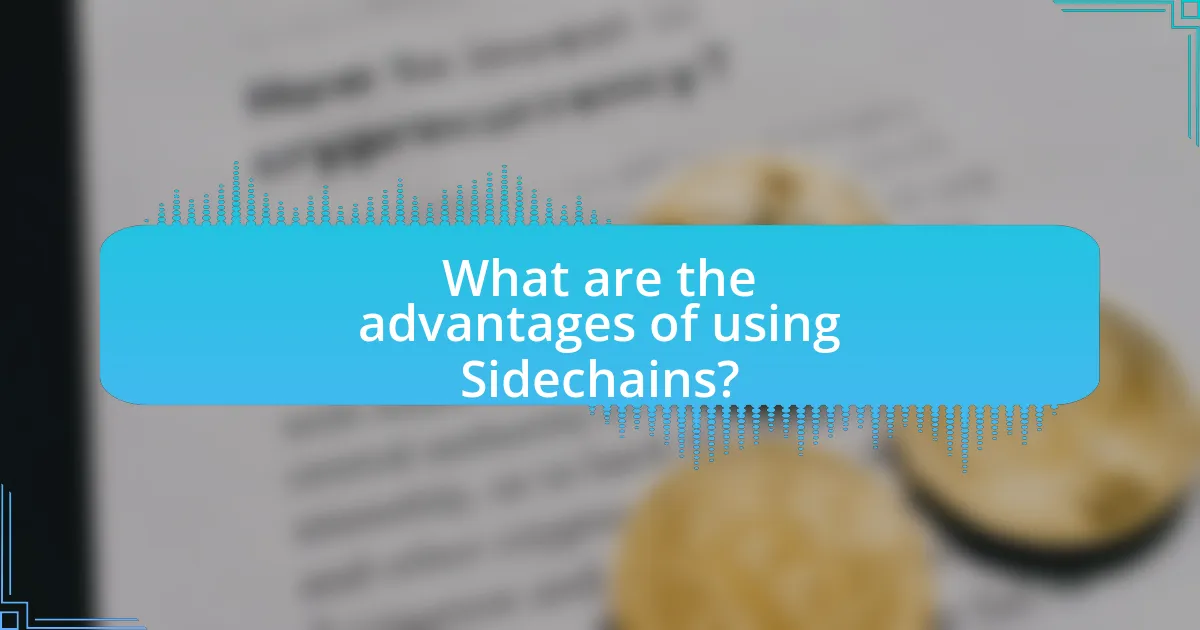
What are the advantages of using Sidechains?
Sidechains offer several advantages, including enhanced scalability, flexibility, and improved security for blockchain networks. By allowing assets to be transferred between the main blockchain and the sidechain, sidechains can process transactions independently, reducing congestion on the main chain and enabling faster transaction times. Additionally, sidechains can implement different consensus mechanisms and features tailored to specific use cases, providing developers with the flexibility to innovate without affecting the main blockchain. Furthermore, sidechains can enhance security by isolating potential vulnerabilities, as any issues on the sidechain do not directly compromise the main chain. These benefits make sidechains a valuable solution for addressing scalability challenges in blockchain technology.
How do Sidechains enhance transaction speed?
Sidechains enhance transaction speed by allowing transactions to occur on a separate blockchain that operates parallel to the main blockchain. This separation reduces congestion on the main chain, enabling faster processing times for transactions. For instance, sidechains can handle a higher volume of transactions simultaneously without affecting the main chain’s performance, as they utilize their own consensus mechanisms and block times. This capability is evidenced by projects like Liquid Network, which allows Bitcoin transactions to be processed more quickly by using a sidechain specifically designed for faster transfers.
What role does consensus mechanism play in Sidechains?
The consensus mechanism in sidechains is crucial for validating transactions and maintaining the integrity of the blockchain. It ensures that all participants agree on the state of the sidechain, which is essential for preventing double-spending and ensuring security. For instance, sidechains can utilize different consensus algorithms, such as Proof of Stake or Delegated Proof of Stake, which can enhance scalability and efficiency compared to the main blockchain. This flexibility allows sidechains to tailor their consensus mechanisms to specific use cases, optimizing performance while still being anchored to the security of the main chain.
How do Sidechains improve user experience?
Sidechains improve user experience by enabling faster transactions and reducing congestion on the main blockchain. This is achieved through the ability to process transactions independently, allowing users to experience quicker confirmation times. For instance, sidechains can handle specific applications or use cases, which alleviates the load on the primary network, resulting in lower fees and improved performance. Additionally, sidechains often support different consensus mechanisms, which can enhance security and scalability tailored to specific needs, further enriching the overall user experience.
What are the security implications of Sidechains?
Sidechains introduce specific security implications primarily due to their reliance on separate consensus mechanisms and the potential for reduced security compared to the main blockchain. Unlike Layer 2 solutions, which typically inherit the security of the main chain, sidechains operate independently, making them vulnerable to attacks if their own security measures are not robust. For instance, if a sidechain uses a less secure consensus algorithm, it may be more susceptible to double-spending attacks or other vulnerabilities. Additionally, the transfer of assets between the main chain and sidechain can pose risks, as flaws in the bridging mechanism could lead to loss or theft of assets. These factors highlight the importance of thorough security assessments and robust design in the implementation of sidechains.
How do Sidechains ensure asset security?
Sidechains ensure asset security by utilizing a two-way peg mechanism that allows assets to be transferred between the main blockchain and the sidechain securely. This mechanism involves locking assets on the main chain and issuing equivalent tokens on the sidechain, which are then governed by their own consensus rules and security protocols. The security of assets is further enhanced through cryptographic proofs and validation processes that ensure only authorized transactions occur, thereby preventing double-spending and unauthorized access. Additionally, sidechains can implement their own security measures, such as decentralized validators or specific consensus algorithms, to bolster the overall integrity of the assets being managed.
What are the potential risks associated with Sidechains?
The potential risks associated with sidechains include security vulnerabilities, interoperability issues, and reliance on the sidechain’s governance model. Security vulnerabilities arise because sidechains may not inherit the same level of security as the main blockchain, making them susceptible to attacks. For instance, if a sidechain has a lower hash rate or fewer validators, it can be more easily compromised. Interoperability issues can occur when transferring assets between the main chain and the sidechain, leading to potential loss or theft of assets if the mechanisms for transfer are not robust. Additionally, reliance on the sidechain’s governance model can pose risks, as centralized control or poor decision-making by a small group can negatively impact users. These risks highlight the importance of thorough evaluation and understanding before utilizing sidechains for scalability solutions.

What are the advantages of using Layer 2 Solutions?
Layer 2 solutions provide significant advantages, primarily by enhancing scalability and reducing transaction costs on blockchain networks. These solutions, such as state channels and rollups, enable faster transaction processing by offloading some of the workload from the main blockchain, which can lead to increased throughput. For instance, Ethereum’s rollups can process thousands of transactions per second compared to the main chain’s limitations. Additionally, Layer 2 solutions often result in lower fees, as they aggregate multiple transactions into a single batch, minimizing the cost per transaction. This efficiency is crucial for applications requiring high-frequency transactions, such as decentralized finance (DeFi) platforms.
How do Layer 2 Solutions improve transaction throughput?
Layer 2 solutions improve transaction throughput by processing transactions off the main blockchain, thereby reducing congestion and increasing speed. These solutions, such as state channels and rollups, allow multiple transactions to be bundled and settled in a single on-chain transaction, significantly enhancing the number of transactions per second. For instance, Ethereum’s Optimistic Rollups can increase throughput to thousands of transactions per second compared to the base layer’s limitations of around 15 transactions per second. This offloading of transaction processing alleviates the burden on the main chain, allowing for faster confirmations and lower fees, which are critical for scalability in blockchain networks.
What technologies are commonly used in Layer 2 Solutions?
Layer 2 solutions commonly utilize technologies such as state channels, sidechains, and rollups. State channels enable off-chain transactions that are settled on-chain, significantly reducing congestion and fees. Sidechains operate independently from the main blockchain, allowing for faster transactions and specialized functionalities. Rollups, including Optimistic and ZK-Rollups, bundle multiple transactions into a single one, enhancing scalability while maintaining security through the main chain. These technologies collectively address scalability challenges by improving transaction speed and reducing costs, as evidenced by their implementation in various blockchain networks like Ethereum.
How do Layer 2 Solutions reduce fees for users?
Layer 2 solutions reduce fees for users by processing transactions off the main blockchain, which alleviates congestion and lowers costs. These solutions, such as state channels and rollups, bundle multiple transactions together before submitting them to the main chain, significantly decreasing the amount of data that needs to be recorded on-chain. For instance, Ethereum’s Optimistic Rollups can reduce transaction fees by up to 90% compared to on-chain transactions, as they minimize the computational load and data storage requirements on the primary network.
What are the security considerations for Layer 2 Solutions?
Layer 2 solutions face several security considerations, primarily including the risk of centralization, potential for fraud proofs, and reliance on the underlying Layer 1 blockchain’s security. Centralization can occur if a small number of operators control the Layer 2 network, which may lead to vulnerabilities and reduced trust. Fraud proofs are essential for ensuring that transactions are valid; if they are not implemented correctly, malicious actors could exploit the system. Additionally, the security of Layer 2 solutions is inherently tied to the security of the Layer 1 blockchain; if the base layer is compromised, the Layer 2 solution may also be at risk. These considerations highlight the importance of robust design and implementation in Layer 2 solutions to maintain security and user trust.
How do Layer 2 Solutions maintain the security of the main blockchain?
Layer 2 solutions maintain the security of the main blockchain by leveraging the underlying security mechanisms of the primary chain while processing transactions off-chain. These solutions, such as state channels and rollups, ensure that the final state of transactions is periodically committed to the main blockchain, which acts as a secure anchor. For instance, in the case of rollups, transaction data is bundled and submitted to the main chain, allowing for verification and fraud-proof mechanisms that rely on the main blockchain’s consensus. This design minimizes the risk of double-spending and ensures that the integrity of the main blockchain is upheld, as any fraudulent activity can be challenged and resolved through the main chain’s established protocols.
What vulnerabilities should users be aware of with Layer 2 Solutions?
Users should be aware of several vulnerabilities associated with Layer 2 solutions, including security risks, reliance on the underlying Layer 1 blockchain, and potential for centralization. Security risks arise from smart contract bugs or exploits, which can lead to loss of funds; for instance, the 2020 hack of the bZx protocol highlighted vulnerabilities in Layer 2 implementations. Additionally, Layer 2 solutions often depend on the security of the Layer 1 blockchain, meaning if the base layer is compromised, the Layer 2 solution may also be at risk. Centralization concerns can emerge if a small number of operators control the Layer 2 network, which can undermine the decentralized ethos of blockchain technology.
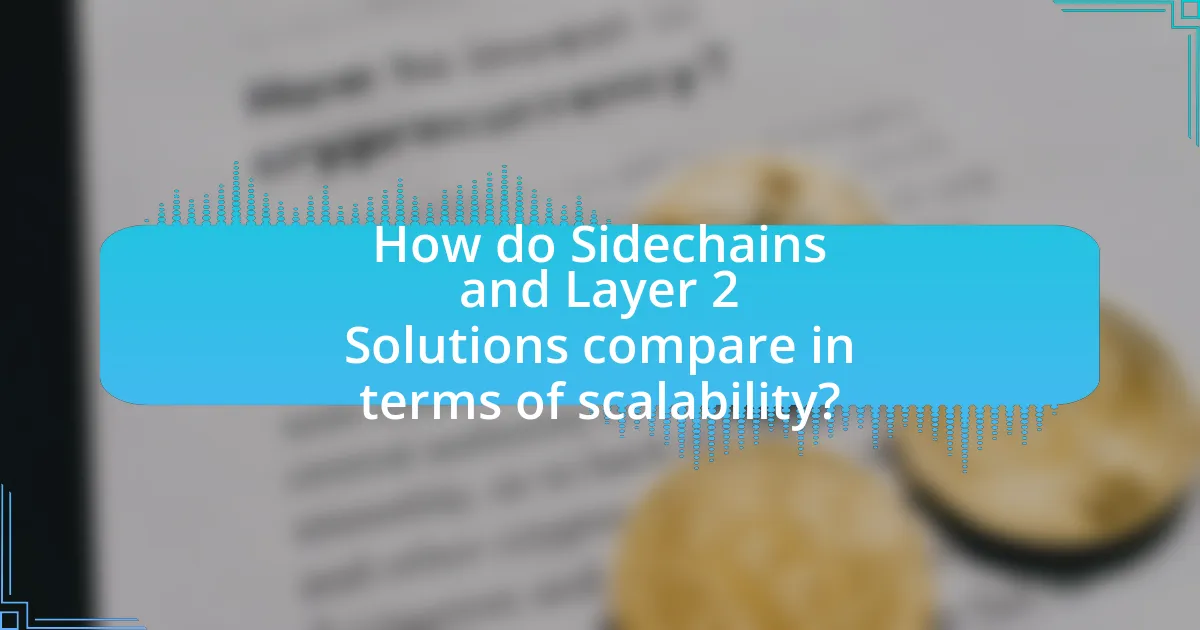
How do Sidechains and Layer 2 Solutions compare in terms of scalability?
Sidechains and Layer 2 solutions both enhance blockchain scalability but do so through different mechanisms. Sidechains operate independently from the main blockchain, allowing for transactions to be processed off the main chain, which can significantly increase throughput and reduce congestion. For instance, the Liquid Network, a Bitcoin sidechain, enables faster transactions by allowing assets to move off the main Bitcoin blockchain, thus alleviating its load.
In contrast, Layer 2 solutions, such as the Lightning Network for Bitcoin or Optimistic Rollups for Ethereum, build on top of the main blockchain and facilitate faster transactions by bundling multiple transactions into a single one before settling on the main chain. This method can dramatically increase transaction speed and lower fees, as seen with the Lightning Network, which can handle millions of transactions per second compared to Bitcoin’s base layer.
Both approaches effectively improve scalability, but sidechains offer more flexibility in terms of governance and functionality, while Layer 2 solutions maintain a closer relationship with the main blockchain, ensuring security and decentralization.
What are the key metrics for comparing scalability?
The key metrics for comparing scalability include throughput, latency, cost efficiency, and resource utilization. Throughput measures the number of transactions processed per second, indicating how well a solution can handle increased demand. Latency refers to the time taken to confirm a transaction, affecting user experience and system responsiveness. Cost efficiency evaluates the expenses associated with processing transactions, which is crucial for long-term sustainability. Resource utilization assesses how effectively a solution uses available computational and storage resources, impacting overall performance. These metrics provide a comprehensive framework for evaluating the scalability of sidechains and Layer 2 solutions.
How do transaction speeds compare between Sidechains and Layer 2 Solutions?
Transaction speeds for Sidechains generally range from a few seconds to a couple of minutes, while Layer 2 Solutions, such as state channels or rollups, can achieve speeds of under a second. Sidechains operate independently from the main blockchain, allowing for faster processing but potentially less security, whereas Layer 2 Solutions leverage the main blockchain’s security while optimizing transaction throughput. For example, Ethereum’s Optimistic Rollups can process thousands of transactions per second, significantly outperforming typical Sidechain speeds.
What are the cost implications of using Sidechains versus Layer 2 Solutions?
Sidechains generally incur lower transaction fees compared to Layer 2 solutions due to their independent blockchain architecture, which allows for more flexible fee structures. For instance, sidechains can optimize their transaction costs based on their own consensus mechanisms and network conditions, while Layer 2 solutions, such as state channels or rollups, often require additional fees for on-chain interactions and may involve costs associated with the underlying main chain.
Moreover, sidechains can be tailored for specific use cases, potentially reducing operational costs. In contrast, Layer 2 solutions may involve higher costs due to the complexity of maintaining state and ensuring security across multiple layers. For example, the Ethereum network’s rollups have been reported to have transaction fees that can vary significantly based on network congestion, while sidechains like Polygon have demonstrated lower fees in various use cases.
Thus, while both solutions aim to enhance scalability, sidechains typically offer a more cost-effective option for users looking to minimize transaction expenses.
Which use cases are best suited for Sidechains and Layer 2 Solutions?
Sidechains and Layer 2 solutions are best suited for use cases that require scalability, faster transaction speeds, and reduced fees. These solutions effectively address the limitations of main blockchain networks by enabling off-chain transactions, which can significantly enhance user experience in applications such as decentralized finance (DeFi), gaming, and non-fungible tokens (NFTs). For instance, DeFi platforms benefit from Layer 2 solutions like Optimistic Rollups, which allow for quicker transactions and lower costs, facilitating high-frequency trading and lending activities. Additionally, gaming applications utilize sidechains to manage in-game assets and transactions without congesting the main blockchain, ensuring smooth gameplay. The Ethereum network’s congestion issues during peak times further validate the need for these solutions, as they allow for increased throughput and efficiency.
What industries benefit most from Sidechains?
The industries that benefit most from sidechains include finance, gaming, supply chain management, and healthcare. In finance, sidechains enable faster transactions and lower fees, enhancing the efficiency of decentralized finance (DeFi) applications. The gaming industry utilizes sidechains to improve scalability and reduce latency, allowing for seamless in-game transactions. In supply chain management, sidechains facilitate real-time tracking and verification of goods, enhancing transparency and efficiency. Healthcare benefits from sidechains by enabling secure and efficient sharing of patient data across different systems, ensuring privacy and compliance with regulations. These applications demonstrate the versatility and effectiveness of sidechains across various sectors.
What industries benefit most from Layer 2 Solutions?
The industries that benefit most from Layer 2 solutions include finance, gaming, supply chain management, and decentralized applications (dApps). In finance, Layer 2 solutions enhance transaction speed and reduce costs, making them ideal for high-frequency trading and micropayments. The gaming industry leverages these solutions to facilitate in-game transactions and improve user experience by minimizing latency. Supply chain management utilizes Layer 2 for real-time tracking and verification of goods, enhancing transparency and efficiency. Lastly, dApps benefit from Layer 2 by achieving scalability and lower transaction fees, which are crucial for user adoption and functionality. These industries demonstrate the practical applications and advantages of Layer 2 solutions in addressing scalability challenges.
What are the best practices for implementing Sidechains and Layer 2 Solutions?
The best practices for implementing Sidechains and Layer 2 Solutions include ensuring interoperability, maintaining security, optimizing transaction throughput, and providing user-friendly interfaces. Interoperability allows seamless communication between the main blockchain and the sidechain or Layer 2 solution, which is crucial for user adoption and functionality. Security must be prioritized by employing robust consensus mechanisms and regular audits to prevent vulnerabilities, as evidenced by the numerous hacks in the blockchain space. Optimizing transaction throughput involves selecting appropriate scaling techniques, such as state channels or rollups, which can significantly enhance performance; for instance, Ethereum’s rollups have demonstrated the ability to process thousands of transactions per second. Lastly, user-friendly interfaces are essential to facilitate adoption, as complex systems can deter users; successful implementations often feature intuitive designs that simplify interactions.
How can developers ensure optimal performance with Sidechains?
Developers can ensure optimal performance with sidechains by implementing efficient consensus mechanisms and optimizing transaction throughput. Efficient consensus mechanisms, such as Proof of Authority or Delegated Proof of Stake, reduce the time and resources needed for transaction validation, leading to faster processing times. Additionally, optimizing transaction throughput involves designing the sidechain to handle a high volume of transactions simultaneously, which can be achieved through techniques like sharding or batching transactions. These strategies have been validated by various projects, such as the use of the Plasma framework in Ethereum, which demonstrates significant improvements in scalability and performance.
What strategies can be employed for effective Layer 2 Solution deployment?
Effective Layer 2 Solution deployment can be achieved through strategies such as optimizing transaction throughput, ensuring interoperability with Layer 1, and implementing robust security measures. Optimizing transaction throughput involves selecting the appropriate consensus mechanism and minimizing latency to enhance user experience. Ensuring interoperability with Layer 1 allows seamless communication between the Layer 2 solution and the main blockchain, which is crucial for maintaining data integrity and user trust. Implementing robust security measures, such as fraud proofs and regular audits, protects against vulnerabilities and enhances the overall reliability of the Layer 2 solution. These strategies are supported by successful implementations like the Lightning Network for Bitcoin, which demonstrates increased transaction speeds and reduced costs while maintaining security and interoperability.












